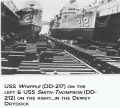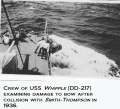Click On Image
For Full Size Image |
Size |
Image Description |
Contributed
By |
Namesake
|
 |
35k | Abraham Whipple, 1733-1819, American Revolutionary naval officer, b. Providence, R.I. In 1759-60, as captain of the privateer Game Cock in the French and Indian Wars, he captured numerous prizes. Whipple commanded the party of Rhode Islanders that captured and burned the British revenue cutter Gaspee in Narragansett Bay in 1772, one of the most provocative instances of resistance to the British in the pre-Revolutionary period. At the beginning of the American Revolution he was made commodore of Rhode Island's small fleet and then became fourth-ranking captain in the Continental navy. With the Columbus in 1776 he fought the first sea fight of the war. In 1778, Whipple, commanding the Providence, evaded the British blockade of Narragansett Bay and carried important government dispatches to France. His most daring exploit occurred in 1779 when, as commander of several vessels, he encountered the large, well-protected British Jamaica fleet. Whipple, concealing the guns of his flagship, the Providence, hoisted the British flag and fell in with the fleet for several days. Each night he cut out one of the merchant ships, manned it from his own crew, and sent it to an American port. Eight of the 11 captured ships reached port, making this one of the richest hauls of the war. In 1780 he was charged with the naval defense of Charleston, S.C.; the city fell and Whipple was captured and held prisoner for the rest of the war. | Bill Gonyo |
USS Whipple (DD-217)
|
 |
40k | Undated, location unknown. | Paul Rebold |
 |
66k | Undated, location unknown. Digital ID: ggbain 36377, Library of Congress Prints and Photographs Division. | Bill Gonyo |
 |
174k | Undated, location unknown. Photo from the collection of the Vallejo Naval and Historical Museum. | Darryl Baker |
 |
76k | Undated, Starboard side view of the USS Whipple (DD-217) at Sydney, NSW, Australia. Except for the Measure 21 camouflage scheme, the ship has no major wartime modifications. Source: Australian War Memorial, Photo No. 302772. | Mike Green |
 |
105k | Undated, location unknown. | Richard Miller BMCS USNR RET. |
 |
113k | Undated, USS Whipple (DD-217) and USS Borie (DD-215) in drydock in Olongapo, Philippines. | Richard Miller BMCS USNR RET. |
 |
117k | The launching November 6 1919. From the book The Ships of the United States Navy and their Sponsors 1913-1923. | - |
 |
119k | Nest of destroyers moored off Dolmabahçe Palace upriver from Istanbul circa 1919. | Cüneyt Demir |


Circa 1920, in drydock in Constantinople (Istanbul). Second photo is the CO and XO. From the collection of CDR Richard F. Bernard. | Kristina Magill |
 |
110k | USS Whipple (DD-217) passing under the Levensau Bridge, while transiting the Kiel Canal, Germany in 1927. Courtesy of Donald M. McPherson, 1969. U.S. Naval History and Heritage Command Photograph. Photo #: NH 67475. | Robert Hurst |
 |
74k | Photo #: 80-G-1025121, USS Black Hawk (AD-9) at Manila, Philippine Islands, 15 November 1935, with four destroyers and USS Heron (AM-10) nested alongside. The four destroyers are (from left to right): USS Whipple (DD-217); USS John D. Edwards (DD-216); USS Smith Thompson (DD-212); and USS Barker (DD-213). All ships are "full dressed" with flags in honor of the inauguration of Philippine President Manuel Quezon. Official U.S. Navy Photograph, now in the collections of the National Archives. | Tony Cowart |
 |
80k | While on exercises in Subic Bay during the spring of 1936, Whipple (DD-217) and Smith Thompson (DD-212) collided on 14 April. The latter suffered such serious damage in the mishap that she had to be scrapped. As a consequence, Whipple, whose own bow had been bent around until it faced sternward, received Smith-Thompson's undamaged bow and soon reentered active service. | Donald Nicholson |



USS Smith-Thompson (DD-212)


USS Whipple (DD-217)
Views of the aftermath of the collision, April 14 1936. | Don Kehn, Jr. |
 |
145k | National Archives photo 19-N-16498. USS Whipple (DD 217) with USS Smith Thompson (DD 212) along side at Subic Bay in April 1936. | Darryl Baker |
 |
125k | National Archives photo 80-G-1024964. The bow of the USS Whipple (DD 217) bow at Subic Bay in April 1936. | Darryl Baker |
 |
87k | National Archives photo 80-G-451214. Bow on view of USS Whipple (DD 217) at Subic Bay in April 1936. | Darryl Baker |
 |
146k | USS Whipple (DD 217) and USS Smith Thompson (DD-212) at Subic Bay in April 1936. From the collection of LCDR Rayborn M. Hall USN who served aboard the USS Bulmer (DD-222) during this incident. | Nancy Hall Anderson |
 |
146k | As above | Nancy Hall Anderson |
 |
241k | As above | Nancy Hall Anderson |
 |
202k | As above | Nancy Hall Anderson |




More scenes of the aftermath of the collision | Navy Memorial via Richard Lillie & Don Kehn, Jr. |

0521232 |
486k | Whipple and Smith Thompson moored in Dewey Drydock (YFD-1) three days after their collision, 17 April 1936.
Naval History & Heritage Command photo NH 78093, courtesy Rear Admiral O.P. Lattu, (Supply Corps), USN (Ret), 1973 | Robert Hurst |
 |
108k | Survivors of USS Langley (AV-3) pictured on board the destroyer USS Whipple (DD-217). On 22 February 1942, USS Langley (AV-3),
a seaplane tender that before her conversion had been the Navy's first aircraft carrier, departed Fremantle, Australia,with 32 Army Air Corps P-40 fighters aboard.
Her mission was to deliver them to Tjilatjap, Java. Early in the morning of February 27th, Langley rendezvoused with her escorts, the destroyers Whipple (DD-217) and
Edsall (DD-219). At 1140 nine Japanese twin-engine bombers appeared overhead, and commenced bombing runs against the ship. The unlucky tender took five bomb hits,
which set aircraft on her deck afire and damaged her steering. Eventually she went dead in the water, her engines flooded. CDR Robert P. McConnell, Langley's skipper,
issued the order to abandon ship at 1332, and once all survivors had departed the ship, the escorting destroyers tried to send her to the bottom with gunfire and torpedoes.
The oiler Pecos(AO-6) attempted to take aboard Langley survivors from the destroyers Whipple and Edsall on the afternoon of February 27th and the morning of Feb. 28th at Christmas
Island but a raid by Japanese bombers
interrupted the effort. The three ships then steamed out of range of enemy air bases, and completed the transfer of survivors on March 1st. However, at noon on that day
planes from the Japanese carriers Soryu, Hiryu, and Akagi made a series of raids against the ship, eventually sending her to the bottom. Whipple rescued 232 survivors.
Photo courtesy ofthe National Naval Aviation Museum. | Bill Gonyo |

0521736 |
37k | USS Whipple (DD-217) at Sydney, New South Wales, Australia, circa 1942. After escaping from the Netherlands East Indies, Whipple sailed to Melbourne, Australia, and arrived on 23 March, and operated with Australian and New Zealand Navy warships on convoy escort duties along the Great Barrier Reef until 2 May, when she departed Sydney for Pearl Harbor.
Australian War Memorial photo 302772 | Robert Hurst |
 |
301k | Four views of the Whipple at Mare Island on August 9 1942. From the John Dickey collection. | Ed Zajkowski |
 |
300k | As above. | Ed Zajkowski |
 |
297k | As above. | Ed Zajkowski |
 |
129k | USS Whipple (DD-217) and USS Alden (DD-211) at Mare Island on August 9 1942. From the John Dickey collection. | Ed Zajkowski |
 |
112k | USS Whipple (DD 217) off Mare Island on August 10 1942. Photo from the collection of the Vallejo Naval and Historical Museum. | Darryl Baker |
 |
131k | USS Whipple (DD 217) off Mare Island on September 22 1942. Photo from the collection of the Vallejo Naval and Historical Museum. | Darryl Baker |
 |
48k | Captain's Inspection, about July 29 1943, in port at Casablanca, Morocco. Personnel identifiable are: CO, LCDR Vincent J. MEOLA and directly behind him is Chief Boatswain's Mate SNIDER and Yeoman WESTFALL. | Harvey WESTFALL, LCDR, USN, (Retired) |
 |
85k | January 15, 1944 photo getting ready to refuel from escort carrier. | Bill Gonyo |
 |
134k | Undated, War time image. (Same time frame as above) | - |
 |
52k | As the AG-117, location unknown. | Paul Rebold |
 |
97k | Nine U.S destroyers in one of the Philadelphia Naval Shipyard's drydocks. Five of the destroyers being scrapped are old flush deckers including the USS Whipple (DD-217) and the USS Stringham (DD-83). The other four are Porter-class destroyer leaders built in the 1930s. The photograph was taken on 14 March 1946 (Author's Collection). Photo from Warship Boneyards, by Kit and Carolyn Bonner. | Robert Hurst |

